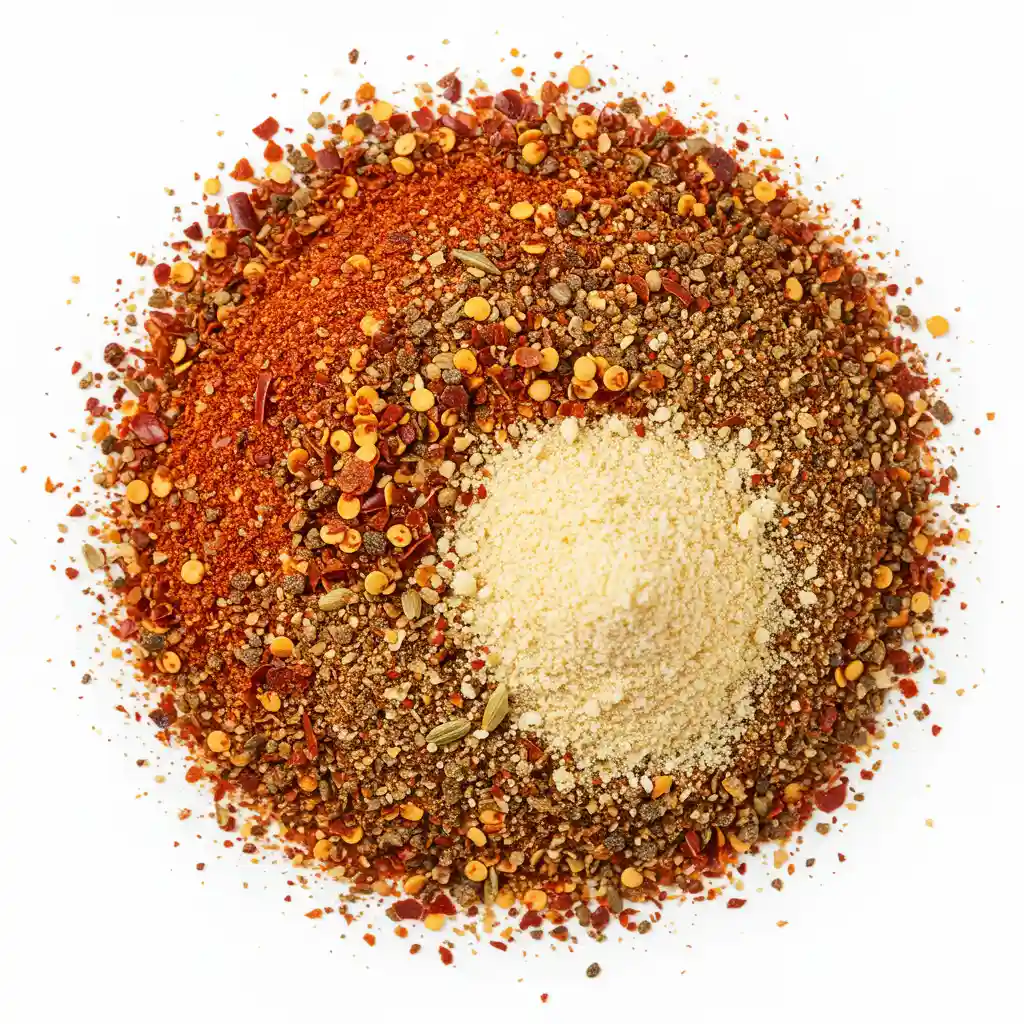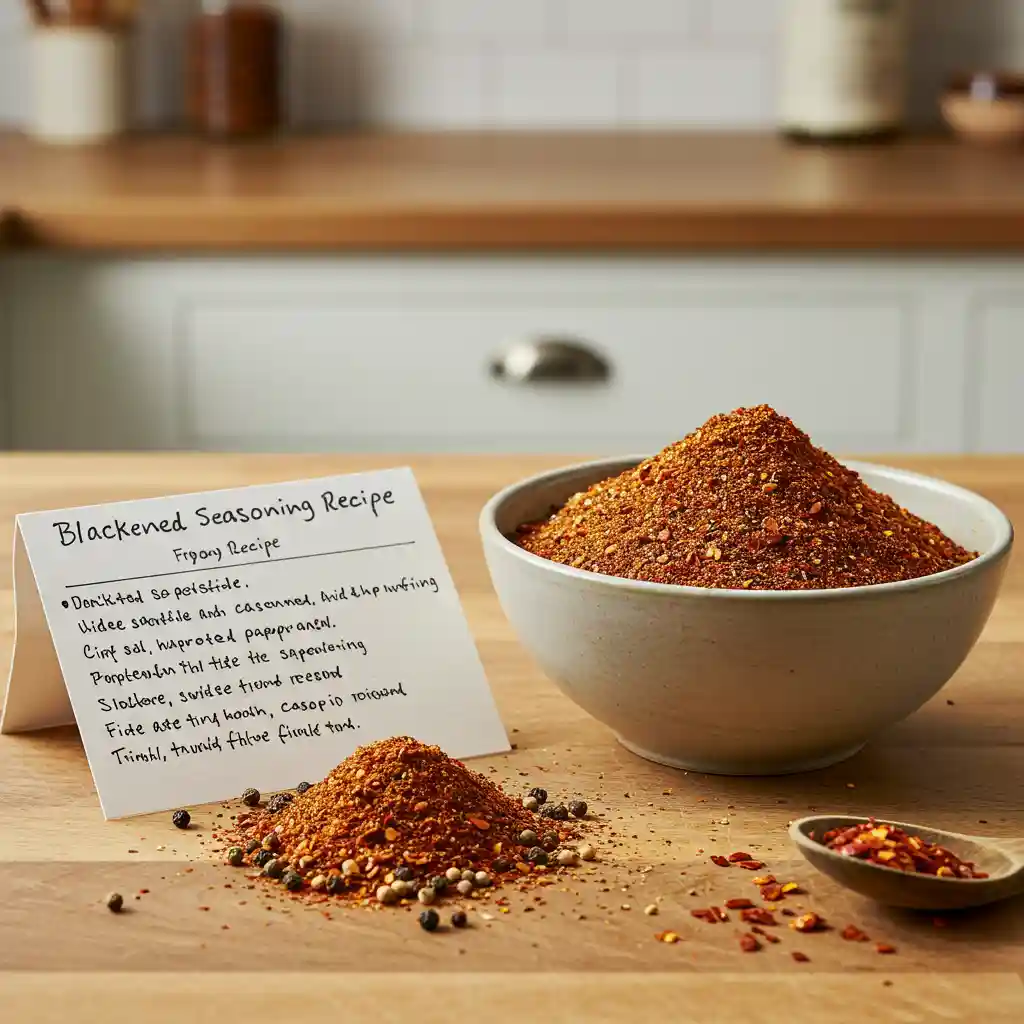Blackened seasoning is a vibrant blend of spices that brings a remarkable depth of flavor to various dishes. This homemade blackened seasoning recipe captures the essence of Cajun and Creole cooking, allowing you to replicate that smoky, spicy taste in your kitchen, much like traditional Cajun spice blends. Whether you’re a seasoned chef or a novice cook, making your own blackened seasoning is not only simple but also ensures you have the best quality ingredients at your fingertips. Let’s explore what blackened seasoning is, its history, and how to create your perfect blend.
Table of Contents
What is Blackened Seasoning?
Understanding Blackened Seasoning
Blackened seasoning is a robust spice mix primarily used to enhance the flavor of meats, seafood, and vegetables. This spice mix usually features paprika, cayenne pepper, garlic powder, and onion powder, delivering a strong and vibrant flavor. The combination of spices not only adds heat but also enhances the umami taste, making it a favorite among home cooks and professional chefs alike, especially when blackening fish and chicken. The “blackening” technique involves coating the food in the seasoning before cooking, which caramelizes the spices and forms a delicious crust. The result is a crispy, flavorful outer layer that locks in moisture and elevates the dish.
History of Blackened Seasoning
Blackened seasoning has its roots in the rich culinary heritage of Louisiana, especially within Cajun and Creole cuisines. This unique cooking method gained widespread popularity in the 1980s, thanks largely to Chef Paul Prudhomme, who is credited with popularizing the blackening technique. His recipes showcased the vibrant flavors and spices characteristic of Louisiana cuisine, and he introduced many people to the idea of blackening fish, meats, and even vegetables. This historical context adds depth to our understanding of blackened seasoning, as it reflects the rich cultural heritage of Southern cooking.
Chef Paul Prudhomme’s Influence
Chef Paul Prudhomme was a pioneering figure in the culinary world, known for his innovative approach to traditional Cajun cooking. In the 1980s, he introduced the concept of blackened seasoning through his restaurant, K-Paul’s Louisiana Kitchen, where he served dishes prepared with his signature spice mix. Prudhomme’s influence extended beyond his restaurant; he authored several cookbooks, and his recipes inspired countless chefs and home cooks to embrace the bold flavors of Louisiana cuisine. His emphasis on fresh herbs and spices, coupled with his techniques, helped to shape modern interpretations of blackened seasoning, ensuring its place in kitchens around the world.

How to Make Blackened Seasoning?
Ingredients for Homemade Blackened Seasoning
To create your homemade blackened seasoning, you’ll need a variety of spices and herbs similar to Cajun and Creole that come together to form a flavorful blend. The essential ingredients include smoked paprika, cayenne pepper, black pepper, garlic powder, onion powder, and dried oregano, which are all key components of a great blackening spice. You might also consider adding thyme, cumin, and a touch of white pepper for an added kick. In addition to adding bold flavor, these spices lend a vibrant color that makes your dishes visually appealing By making your own seasoning mix, you control the quality and quantity of each ingredient, allowing you to tailor the blend to your taste preferences, including granulated garlic.
Step-by-Step Guide to Creating Your Blend
Creating your blackened seasoning blend is a straightforward process that requires minimal effort. Start by measuring out each spice according to your taste and the desired heat level. Combine the spices in a mixing bowl, ensuring they are well blended. You can use a whisk or simply stir with a spoon to achieve a uniform mix. Once your seasoning is blended, consider transferring it to an airtight container for storage. This helps preserve the freshness and potency of the spices, allowing you to enjoy the full flavor every time you use your homemade blackened seasoning. Remember to label the container with the date so you can track its freshness.
Tips for Perfecting Your Seasoning Mix
To perfect your blackened seasoning, consider adjusting the ratios of the spices based on your personal preference for heat and flavor. For those who prefer more heat, you can boost the cayenne pepper or sprinkle in some crushed red pepper flakes For a more aromatic blend, incorporate additional herbs such as basil or thyme. It’s also beneficial to taste the seasoning mix before storing it, allowing you to tweak the flavors as needed. Experimenting with different combinations and ratios will lead you to discover your ultimate blackened seasoning recipe that suits your palate perfectly.
What Foods Can You Blacken?
Best Meats to Use Blackened Seasoning
Blackened seasoning is incredibly versatile and pairs well with various types of meat. The classic choice is chicken, which absorbs the smoky flavors beautifully when cooked in a cast iron skillet. Other excellent options include pork chops and steaks, where the Cajun spice forms a delectable crust while sealing in juices. Additionally, blackened shrimp is a popular dish due to its quick cooking time and bold flavors, making it perfect for weeknight dinners. The versatility of blackened seasoning allows you to experiment with different meats, enhancing your culinary repertoire with exciting and flavorful dishes.
Vegetarian Options for Blackening
Vegetarians can also enjoy the robust flavors of blackened seasoning by using it on a variety of plant-based ingredients. Tofu, when properly pressed and marinated, takes on the seasoning beautifully, providing a satisfying texture and taste. Portobello mushrooms are another great option, as their meaty texture holds up well to the intense flavors of the spice mix. Additionally, vegetables such as bell peppers and zucchini can be tossed in the seasoning and grilled or sautéed for a delicious side dish. By using blackened seasoning on these vegetarian options, you can create meals that are just as flavorful and satisfying as their meat counterparts.
How to Blacken Salmon and Other Fish
Blackening fish, particularly salmon, is a delightful way to enhance its natural flavors. Start by coating the salmon fillets with a generous amount of blackened seasoning, ensuring all sides are well covered. Heat a cast iron skillet over high heat and add a little oil to prevent sticking. Once the skillet is hot, place the seasoned salmon in the pan and cook for a few minutes on each side until a dark crust forms. This method not only adds a burst of flavor but also creates a beautiful presentation with the charred exterior. Other fish varieties, such as tilapia and catfish, can also be prepared using this technique, allowing you to enjoy the rich taste of blackened fish in various forms, especially when dipped in butter.
How to Use Blackened Seasoning?
Cooking Techniques with Blackened Seasoning
Using blackened seasoning effectively can elevate your cooking process and the flavors of your dishes, particularly when applied to fish and chicken. The most common method is the blackening technique, where seasoned proteins are cooked at high temperatures in a cast iron skillet, allowing you to blacken foods to perfection. This technique helps the spices caramelize, forming a flavorful crust. You can also apply blackened seasoning as a dry rub before grilling or roasting to let the flavors soak in and elevate the taste of the meat. Whether you choose to blacken, grill, or roast, the versatility of this seasoning mix guarantees delicious results every time.
Using Blackened Seasoning in Different Recipes
Blackened seasoning can be incorporated into a wide range of recipes beyond just meats and fish. Consider using it to spice up your soups, stews, or even dips, adding depth and flavor to your meals. It can also be mixed into marinades for a flavorful infusion before cooking. Additionally, blackened seasoning works wonderfully in vegetable dishes, enhancing the taste of roasted or sautéed vegetables. By thinking outside the box, you can discover countless ways to use blackened seasoning in your cooking, ensuring that every meal is packed with bold flavors.
Storing Your Seasoning in an Airtight Container
Storing your homemade blackened seasoning correctly is key to preserving its strength and flavor. To ensure maximum freshness, transfer the seasoning mix into an airtight container immediately after preparing it. Sealable glass jars or plastic containers with secure lids are great choices for keeping the seasoning fresh. Keep the container in a cool, dark place, away from direct sunlight and heat sources, as these can degrade the spices, including your blackening spice, over time. By storing your blackening spice correctly, you can enjoy its vibrant flavors for months, making it a staple in your pantry.

Variations of Blackened Seasoning
Spicier Versions of Blackened Seasoning
If you enjoy a fiery kick, consider creating a spicier version of blackened seasoning by increasing the amount of cayenne pepper or adding additional hot spices. You could also experiment with infused spices such as chipotle powder for a smoky heat or crushed red pepper flakes for an extra burst of flavor. The beauty of making your own seasoning is the ability to customize it to your taste preferences, allowing you to enjoy a blackened seasoning blend that packs a punch without sacrificing the essential flavors. This flexibility ensures that every meal can be tailored to your heat tolerance and flavor liking, especially when using Cajun and Creole seasonings.
Cajun vs. Creole: What’s the Difference?
Cajun and Creole cuisines are often mentioned in the same breath, but they have distinct characteristics that set them apart. Cajun seasoning typically has a rustic, bold flavor profile that emphasizes earthy herbs and spices, while Creole seasoning tends to be more refined and complex, often incorporating a wider variety of spices and ingredients. Blackened seasoning is commonly associated with Cajun cuisine, focusing on the deep, smoky flavors that accompany the blackening technique. Understanding these differences allows you to appreciate the nuances in flavor profiles and choose the right seasoning for your cooking needs.
Customizing Your Spice Blend
One of the joys of creating your homemade blackened seasoning is the ability to customize the blend according to your preferences. You can experiment with different herbs and spices to craft a mix that reflects your taste. For instance, adding more garlic powder can enhance the aromatic quality, while incorporating a hint of cumin can provide an additional layer of flavor. Alternatively, you might choose to reduce the heat by cutting back on cayenne pepper or exploring milder spices. This customization process ensures that you have a unique blackened seasoning blend that suits your culinary style and enhances your favorite dishes.
Where to Buy Blackened Seasoning?
Recommended Brands for Blackened Seasoning
If you prefer purchasing blackened seasoning instead of making it at home, several reputable brands offer high-quality blends. Popular options include Tony Chachere’s, Emeril’s, and Zatarain’s, each of which has its unique take on the classic blackened seasoning. These brands are known for their authentic flavors and commitment to quality, making them reliable choices for anyone looking to bring the taste of Louisiana cuisine into their kitchen. When shopping for store-bought seasoning, pay attention to the ingredient list to ensure you’re getting a product that aligns with your flavor preferences.
Choosing Quality Seasoning Mixes
When selecting a blackened seasoning mix, it’s essential to choose quality products that feature fresh spices and garlic and onion powder. Look for blends that contain no artificial preservatives or fillers, as these can diminish the quality of the seasoning. Additionally, consider purchasing from brands that prioritize sourcing their ingredients responsibly. A good blackened seasoning should have a balanced flavor profile that enhances your dishes without overpowering them, similar to Cajun and Creole seasonings. By prioritizing quality, you’ll ensure that your meals are packed with the rich and robust flavors that blackened seasoning is known for.
Making Your Own vs. Store-Bought
Deciding between making your own blackened seasoning or opting for store-bought mixes often depends on personal preference and convenience. While homemade seasoning allows you to customize the flavors and ensure freshness, store-bought options provide convenience and consistency, particularly with Cajun and Creole seasonings. Making your own seasoning can be an enjoyable culinary adventure, allowing you to experiment with different spice combinations. On the other hand, purchasing a well-crafted blend can save time and effort, especially for busy cooks. Ultimately, the choice comes down to your cooking style and how much you value the experience of crafting your spice mix.

Quick FAQs on Blackened Seasonin
What’s in blackened seasoning?
A blend of paprika, cayenne pepper, garlic powder, onion powder, black pepper, oregano, and thyme.
How does it taste?
Spicy, smoky, and savory with a bold kick.
Is it the same as Cajun seasoning?
Similar, but blackened seasoning is specially made for high-heat cooking.
Who popularized it?
Chef Paul Prudhomme in the 1980s.
How do you use it?
Used as a dry rub or marinade on meats, seafood, vegetables, or tofu.
Can you make it at home?
Yes, easily with common spices.
Which meats work best?
Chicken, shrimp, salmon, pork, and steak.
Is it good for vegetarians?
Yes, on tofu, mushrooms, and vegetables.
How to store it?
Stored in a sealed container and kept away from light and heat.
Where to buy it?
Brands like Tony Chachere’s, Emeril’s, and Zatarain’s.

Blackened Seasoning Recipe
Method
- Measure out each spice according to your taste and the desired heat level
- Combine the spices in a mixing bowl, ensuring they are well blended. You can use a whisk or simply stir with a spoon to achieve a uniform mix.
- Transfer it to an airtight container for storage. This helps preserve the freshness and potency of the spices.
- Label the container with the date so you can track its freshness
